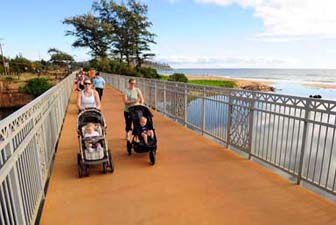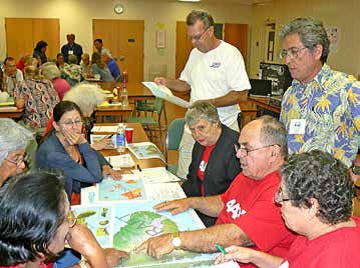A focus on pedestrian safety and the benefits of walking can be seen throughout Hawaii thanks to the nation’s first Statewide Pedestrian Master Plan adopted by the Hawaii Department of Transportation.
Released in May 2013, the Hawaii Statewide Pedestrian Master Plan was developed to improve pedestrian safety, mobility, and connectivity. At the same time, the plan sought to promote the benefits of walking – including a healthier environment, healthier citizens, and a stronger economy.
The plan provides a formalized process to assess the needs of pedestrians, develop and prioritize projects, and provide an implementation strategy, according to Rachel Roper, the project manager for the plan and a civil engineer with the HDOT Highways Division Planning Branch.
The plan identifies ways to improve pedestrian safety and mobility through engineering, education, and enforcement. It prioritizes 31 pedestrian infrastructure projects, advances the state’s complete streets policy, and fulfills federal multimodal planning requirements.
A key component of the plan is the Hawaii Pedestrian Toolbox, a companion document containing best practices for planning, design, operation, and maintenance of pedestrian facilities.

Features such as this pedestrian bridge on the east shore of Kauai are described in the Hawaii Pedestrian Toolbox. (photo: Hawaii DOT)
To ensure effective implementation, the plan also describes potential funding strategies and provides performance measures for monitoring progress. The performance measures reflect specific objectives and methods to achieve the following goals of the plan:
- improve pedestrian mobility and accessibility;
- improve pedestrian safety;
- improve connectivity of the pedestrian network;
- promote environmental benefits of walking;
- encourage walking to foster healthy lifestyles;
- enhance communities and economic development by creating pedestrian-oriented areas and positive pedestrian experiences; and
- promote and support walking as an important transportation mode that reduces overall energy use.
Examples of the pedestrian projects HDOT is advancing include implementing Walk Wise Hawaii, a program to educate communities about pedestrian and driver awareness; replacing traditional traffic signals with countdown timers; and installing sidewalks to improve connectivity.
The American Planning Association recognized Hawaii’s pedestrian plan with its 2014 National Planning Award for Excellence in Transportation Planning, citing the plan for being the first in the nation with a statewide, pedestrian-only focus and for being transferable to other states.
HDOT’s efforts in engaging the public and identifying priority areas of concern also were featured as noteworthy practices in the Federal Highway Administration’s Statewide Pedestrian and Bicycle Planning Handbook, released in September 2014.
Developing the Plan
HDOT sought to develop a pedestrian-focused plan to fulfill a goal of reducing traffic-related deaths in Hawaii’s Strategic Highway Safety Plan, 2007-2012. Hawaii had the fifth highest pedestrian fatality rate nationwide due to traffic-related crashes from 2001-2005, with 22 percent of traffic crashes statewide involving pedestrians.
The agency structured the plan development process to balance technical expertise from HDOT’s Highway Design and Traffic Operations Sections with extensive involvement from the public, Roper said. HDOT established two stakeholder committees: a Technical Advisory Committee and a Citizens Advisory Committee. The technical group was comprised of staff from federal, state, and city and county agencies. The citizens committee represented diverse public interests, such as neighborhood organizations, seniors, students, local businesses, and minority and disadvantaged populations. HDOT also held a series of public meetings and workshops and maintained a project website throughout the plan development process.

The public validates existing conditions at a public workshop in Maui. (Photo Hawaii DOT)
The project team identified “areas of concern” for recommended pedestrian improvements through a geographic information system analysis of existing conditions statewide. This was combined with input from the stakeholder committees and the public. Criteria to evaluate the areas of concern and to prioritize recommended solutions were developed based on the key factors of pedestrian connectivity, accessibility, pedestrian-oriented populations, and safety. The criteria were reviewed by the two advisory groups and validated through public meetings.
The project team then applied best practices in pedestrian-oriented design from the companion Hawaii Pedestrian Toolbox to evaluate potential solutions in the areas of engineering, education, and enforcement. The process – which included sharing potential solutions with the citizens’ advisory committee and the public – resulted in a prioritized list of 31 recommended pedestrian projects and programs.
Lessons Learned
HDOT invested a lot of time with stakeholder groups to develop a comprehensive set of goals, objectives, and recommendations addressing all the facets of pedestrian issues, Roper said.
“While the extensive process of public and stakeholder involvement was immensely valuable, it was also challenging and added a lot of time to the plan development process,” Roper said. This is something that other state DOTs should consider when developing a project schedule or contract.
Roper also emphasized that it’s important to approach the process holistically, including both technical and nontechnical staff as well as internal and external stakeholders. “It can’t be thought of separately and then just mushed together at the end,” she said.
Having an established process for decision-making and sharing of information between the project team and stakeholders at the start of the process also was key, Roper said. HDOT was doing extensive outreach, and there was a lot of interest in the project from the public, community groups, the media, and others.
“A lot of people wanted to provide input and wanted to see it in the plan, but some were afraid that all the input we received would go into a ‘black box’ somewhere and get lost,” according to Roper. “It was important to ensure that accurate and consistent information was being disseminated” so everyone involved could see how information was used in the plan.
The process also featured a two-way information flow between the project committees and stakeholder groups throughout, Roper said. Members of the technical committee attended public meetings, as did HDOT leadership, when possible.
Other challenges included scheduling meetings with stakeholders who have busy schedules; collecting and responding to the many comments; and balancing the wide variety of opinions.
Ultimately, HDOT wanted the plan to be implemented by its staff and not to “just sit on the shelf,” Roper said. The agency conducted internal roll-out sessions to make sure staff needs were addressed and that “everyone involved in the project delivery process, including planning, design, construction, operations, and maintenance, was aware of the plan and felt it was feasible and implementable.” In the end, this extensive and transparent public involvement process succeeded in generating a lot of support for the plan, both within HDOT and externally, and was a key contributor to the success of the plan and its implementation, Roper said.
For more information, link to the Statewide Pedestrian Master Plan and Hawaii Pedestrian Toolbox or contact Rachel Roper, HDOT Highways Division Planning Branch, at [email protected].